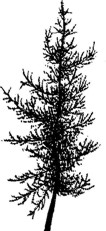|
SILVICS OF TAMARACK
(Larix laricina (Du Roi) K. Koch.)
Common names:
- larch, juniper (not a true juniper), hackmatack
Field identification aids:
- has smallest cone of native conifers
- many needles in a cluster
- soft, blue-green needles that turn yellow in autumn
Average mature tree:
- 50 to 70 years old
- 12 m to 20 m (40' to 67') tall
- 30 cm to 60 cm (12" to 24") in diameter at breast height
Maximum life span:
- 150 years
Shade tolerance:
- very intolerant
Rooting:
- shallow and wide-spreading
Windfirmness:
- moderately windfirm
Reproduction:
- reproduces by seed
- occasionally reproduces by layering
- will bear seed as early as 12 years old with full production after 40 years
- best germination on moist mineral or organic soil with light cover
- good cone crop every 3 to 6 years
Growing sites:
- range from upland sites to bogs
- best growth is on well-drained soils with very little clay (light soils)
- usually found on wet sites
Associated species:
- black spruce and red maple on poor sites
- on better sites occurs with trembling aspen, white birch and balsam fir
Principal damaging agents:
- larch sawfly, larch casebearer, white-marked tussock moth, and porcupines
Notes:
- tamarack comprises 1.7% of the merchantable volume in Nova Scotia
- fastest growing softwood on a good site
- characteristic tree of swamps and bogs
- very durable for outdoor projects
|


